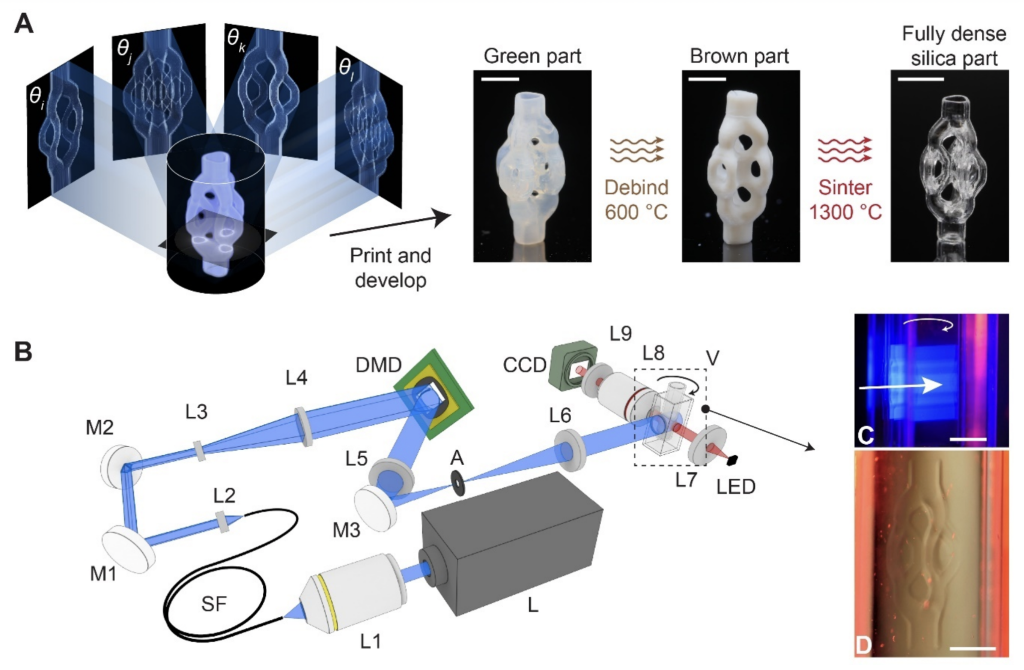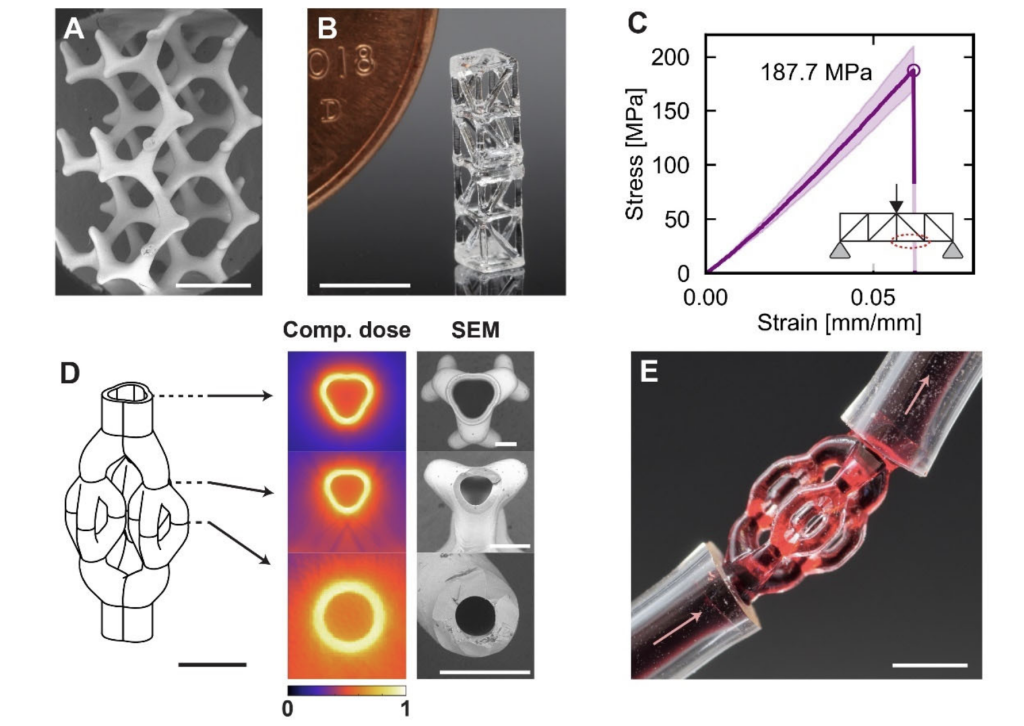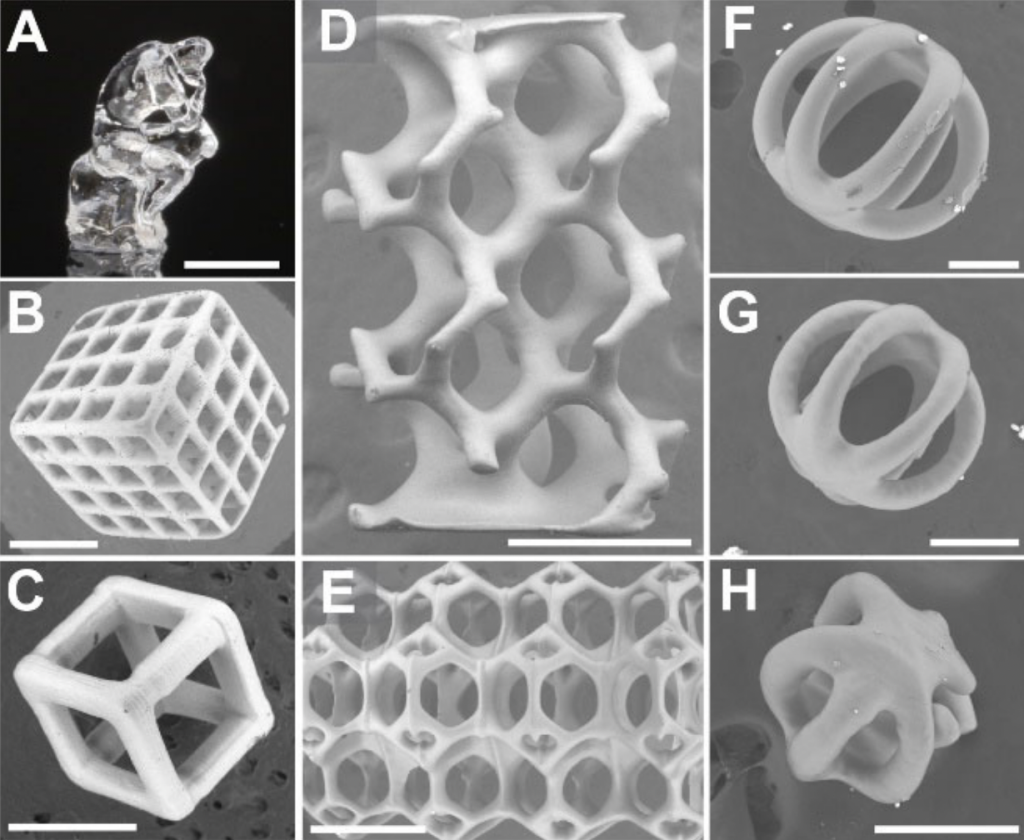Researchers at the University of Freiburg have worked with colleagues at the University of California, Berkeley to come up with a novel means of rapidly 3D printing complex glass parts at a microscopic scale.
Known as ‘ Microscale Computed Axial Lithography’ (Micro-CAL), this approach involves exposing resin to 2D light images of a desired shape from multiple angles, which when they overlap, trigger polymerization. When used to print the Glassomer material previously honed at Freiburg, the team say their layer-free process has the potential to unlock devices with new microfluidic or micro-optical functionality.
“For the first time, we were able to print glass with structures in the range of 50 micrometers in just a few minutes, which corresponds roughly to the thickness of a hair,” explains the University of Freiburg’s Dr. Frederik Kotz-Helmer. The ability to manufacture such components at high speed and with great geometric freedom will enable new functions and more cost-effective products in the future.”

‘CAL’ vs serial deposition 3D printing
According to the scientists, glass has “innumerable uses” thanks to its high level of optical transparency, as well as its thermal and chemical resistance, and low coefficient of thermal expansion. Given these qualities, it’s hardly surprising that the material is sometimes used within 3D printing as well, however, the researchers say that layer-by-layer deposition can “induce defects” and “limit geometric freedom.”
Though many 3D printing processes rely on serial deposition, one alternative that does exist is Computed Axial Lithography (CAL). Rather than build up objects in layers, CAL polymerizes light-sensitive resins into 3D structures by exposing them to iteratively optimized projections, which in turn, cause them to hit a threshold at which their entire volume hardens simultaneously in a precursor material.
As there’s no relative motion between this precursor and the object being printed, it’s possible to utilize high-viscosity nanocomposites as part of the process. Another benefit of CAL over layer-by-layer techniques, is that supports aren’t required to hold builds in place, hence the process is potentially better suited to creating intricate microstructures.

‘Micro-CAL’ printing ‘Glassomer’ objects
In order to assess the potential of CAL for producing glass structures at a microscale, the researchers have built their own Micro-CAL system. Equipped with a laser light source combined with a low numerical aperture optical fiber, the prototype has proven capable of demagnifying the light pattern emitted by a digital micromirror device across several tests.
In these experiments, the scientists polymerized a nanoparticle-loaded material inside a nanocomposite resin, which served to suitably support the build, before it was removed and reused in the creation of further objects. Once ready, the resulting green parts were then debinded and sintered, in a process which caused their nanoparticles to bond together, yielding a fully-dense glass component.
This process was made possible by a revised version of the polymer-based silica glass developed by the University of Freiburg and its spin-out Glassomer, tweaked to be both highly transparent, and harden quickly at a predetermined threshold.
In practice, Micro-CAL 3D printing the material enabled the team to produce microstructures in the space of 30-90 seconds, with features down to sizes of 20 µm and 50 µm in plastic and glass respectively. Compared to traditionally-manufactured silica glass, the researchers’ prototypes also featured a higher tensile stress at failure of 187.7 MPa, as their process was found to limit the formation of microcracks and indentation.
With these benefits in mind, the team behind the project believe that Micro-CAL could soon be used as a means of producing various micro-optical parts, ranging from those used in VR headsets to modern microscopes. Given that most lab-on-a-chip devices also rely on the precise integration of complex microfluidic channels, the scientists believe their method can be used in clinical diagnostic tools too.

The emerging field of glass 3D printing
Despite the Freiburg-led research team’s critique of many existing approaches to glass 3D printing, a number of these are now starting to show commercial potential. Formnext 2021 start-up challenge winner Nobula, for instance, told 3D Printing Industry last year that it aimed to bring a dedicated glass 3D printer and feedstock to market in 2022.
On a similarly commercial note, Optiswiss installed Luxexcel’s VisionPlatform 7 platform in November 2021, with the aim of using it to 3D print lenses for eyewear customers. After the deal was signed, Optiswiss CEO Samuel Frei claimed that it gave his firm “a clear path towards the large-volume manufacturing of prescription smart glasses.”
At an experimental level, scientists at the University of Freiburg have also worked with Nanoscribe in the past to 2PP 3D print glass silica microstructures. Again, through the use of Glassomer materials, the project participants found they were able to create complex objects with a surface roughness of just 6 nanometers, significantly less than the 40-200 nanometers seen in many other glass parts.
The researchers’ findings are detailed in their paper titled “Volumetric Additive Manufacturing of Silica Glass with Microscale Computed Axial Lithography.” The study was co-authored by Joseph Toombs, Manuel Luitz, Caitlyn Cook, Sophie Jenne, Chi Chung Li, Bastian Rapp, Frederik Kotz-Helmer and Hayden Taylor.
To stay up to date with the latest 3D printing news, don’t forget to subscribe to the 3D Printing Industry newsletter or follow us on Twitter or liking our page on Facebook.
For a deeper dive into additive manufacturing, you can now subscribe to our Youtube channel, featuring discussion, debriefs, and shots of 3D printing in-action.
Are you looking for a job in the additive manufacturing industry? Visit 3D Printing Jobs for a selection of roles in the industry.
Featured image shows a set of ‘Micro-CAL’ 3D printed glass prototypes. Image via the University of Freiburg.



